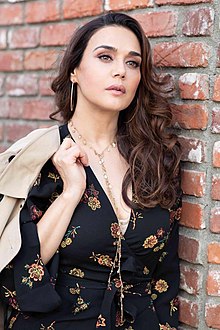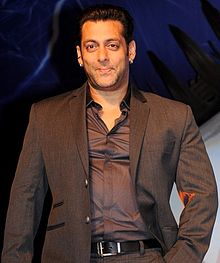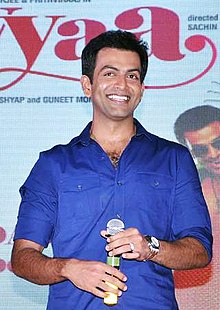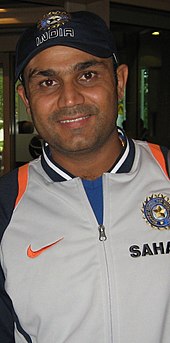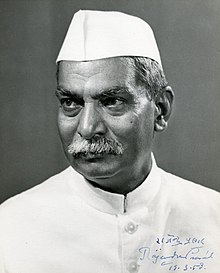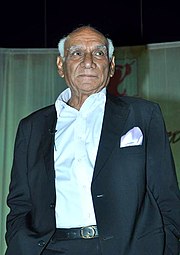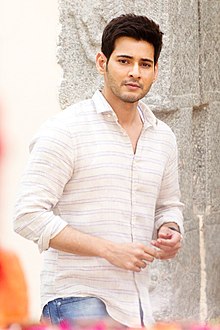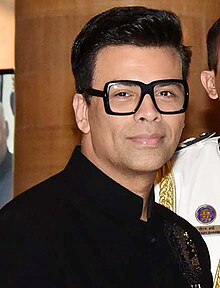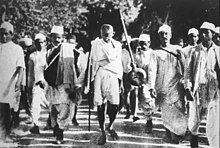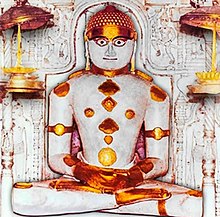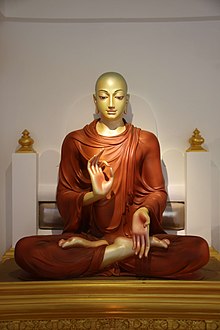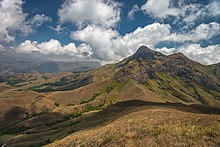Portal:India
Introduction


India, officially the Republic of India, is a country in South Asia. It is the seventh-largest country in the world by area and the most populous country. Bounded by the Indian Ocean on the south, the Arabian Sea on the southwest, and the Bay of Bengal on the southeast, it shares land borders with Pakistan to the west; China, Nepal, and Bhutan to the north; and Bangladesh and Myanmar to the east. In the Indian Ocean, India is in the vicinity of Sri Lanka and the Maldives; its Andaman and Nicobar Islands share a maritime border with Thailand, Myanmar, and Indonesia. (Full article...)
Kangna Amardeep Ranaut (pronounced [kəŋɡənaː raːɳoːʈʰ]; born 23 March 1986) is an Indian actress, filmmaker, and politician serving as a Member of Parliament, Lok Sabha from Mandi since June 2024. Known for her portrayals of strong-willed, unconventional women in female-led Hindi films, she is the recipient of several awards, including four National Film Awards and five Filmfare Awards, and has featured six times in Forbes India's Celebrity 100 list. In 2020, the Government of India honoured her with the Padma Shri, the country's fourth-highest civilian award.
At the age of sixteen, Ranaut briefly took up modelling before being trained under theatre director Arvind Gaur. She made her film debut in the 2006 thriller Gangster, for which she was awarded the Filmfare Award for Best Female Debut, and received praise for portraying emotionally intense characters in the dramas Woh Lamhe... (2006), Life in a... Metro (2007) and Fashion (2008). For the last of these, she won the National Film Award for Best Supporting Actress. She appeared in the commercially successful films Raaz: The Mystery Continues (2009) and Once Upon a Time in Mumbaai (2010) but was criticised for being typecast in neurotic roles. A comic role in Tanu Weds Manu (2011) was well-received, though this was followed by a series of brief, glamorous roles in films that failed to propel her career forward. (Full article...)
Hyderabad (/ˈhaɪdərəbæd/ HY-dər-ə-bad; ISO: Haidarābād, Telugu: [ˈɦaɪ̯daɾaːbaːd] , Urdu: [ˈɦɛːdəɾaːbaːd]) is the capital and largest city of the Indian state of Telangana. It occupies 650 km2 (250 sq mi) on the Deccan Plateau along the banks of the Musi River, in the northern part of Southern India. With an average altitude of 542 m (1,778 ft), much of Hyderabad is situated on hilly terrain around artificial lakes, including the Hussain Sagar lake, predating the city's founding, in the north of the city centre. According to the 2011 census of India, Hyderabad is the fourth-most populous city in India with a population of 6.9 million residents within the city limits, and has a population of 9.7 million residents in the metropolitan region, making it the sixth-most populous metropolitan area in India. With an output of US$ 95 billion, Hyderabad has the sixth-largest urban economy in India.
The Qutb Shahi dynasty's Muhammad Quli Qutb Shah established Hyderabad in 1591 to extend the capital beyond the fortified Golconda. In 1687, the city was annexed by the Mughals. In 1724, Asaf Jah I, the Mughal viceroy, declared his sovereignty and founded the Asaf Jahi dynasty, also known as the Nizams. Hyderabad served as the imperial capital of the Asaf Jahis from 1769 to 1948. As capital of the princely state of Hyderabad, the city housed the British Residency and cantonment until Indian independence in 1947. Hyderabad was annexed by the Indian Union in 1948 and continued as a capital of Hyderabad State from 1948 to 1956. After the introduction of the States Reorganisation Act of 1956, Hyderabad was made the capital of the newly formed Andhra Pradesh. In 2014, Andhra Pradesh was split to form the state of Telangana, and Hyderabad became the joint capital of the two states with a transitional arrangement scheduled to end in 2024. Since 1956, the city has housed the Rashtrapati Nilayam, the winter office of the president of India. (Full article...)
The Indian roller (Coracias benghalensis) is a bird of the family Coraciidae. It is 30–34 cm (12–13 in) long with a wingspan of 65–74 cm (26–29 in) and weighs 166–176 g (5.9–6.2 oz). The face and throat are pinkish, the head and back are brown, with blue on the rump and contrasting light and dark blue on the wings and tail. The bright blue markings on the wing are prominent in flight. The sexes are similar in appearance. Two subspecies are recognised.
The Indian roller occurs widely from West Asia to the Indian subcontinent. Often found perched on roadside trees and wires, it is common in open grassland and scrub forest habitats, and has adapted well to human-modified landscapes. It mainly feeds on insects, especially beetles. The species is best known for the aerobatic displays of males during the breeding season. Adult males and females form pair bonds and raise the young together. The female lays 3–5 eggs in a cavity or crevice, which is lined with a thin mat of straw or feathers. The roller is the state bird of three Indian states. It is listed as a species of least concern on the IUCN Red List. (Full article...)

Kalidas (pronounced [kaːɭidaːs] transl. The Servant of Kali) is a 1931 Indian biographical film directed by H. M. Reddy and produced by Ardeshir Irani. It is notable for being the first sound film in the Tamil and Telugu languages, and the first sound film to be made in a Dravidian language. It was based on the life of the Sanskrit poet Kalidasa, hence its namesake; it featured P. G. Venkatesan in the title role and T. P. Rajalakshmi as the female lead, with L. V. Prasad, Thevaram Rajambal, T. Susheela Devi, J. Sushila, and M. S. Santhanalakshmi in supporting roles.
Kalidas, principally in Tamil, contained additional dialogue in Telugu and Hindi. While Rajalakshmi spoke Tamil, Venkatesan spoke only Telugu due to his lack of fluency in Tamil, and Prasad spoke only Hindi. Despite its mythological theme, the film featured songs from much later time periods, such as the compositions of Carnatic musician Tyagaraja, publicity songs of the Indian National Congress, and songs about Mahatma Gandhi and the Indian independence movement. The sound was recorded using German-made technology. Kalidas was shot in Bombay on the sets of India's first sound film Alam Ara (1931) and was completed in eight days. (Full article...)
The 2000 Sri Lanka cyclone (IMD designation: BOB 06 JTWC designation: 04B) was the strongest tropical cyclone to strike Sri Lanka since 1978. The fourth tropical storm and the second severe cyclonic storm of the 2000 North Indian Ocean cyclone season, it developed from an area of disturbed weather on December 25, 2000. It moved westward, and quickly strengthened under favorable conditions to reach top wind speeds of 75 mph (121 km/h). The cyclone hit eastern Sri Lanka at peak strength, then weakened slightly while crossing the island before making landfall over southern India on December 28. The storm degenerated into a remnant low later that day, before merging with another trough on the next day.
The storm was the first cyclone over Sri Lanka with winds of at least hurricane strength since a cyclone of 1978 hit the island in the 1978 season, as well as the first tropical storm to hit the island since 1992. The storm was also the first December tropical cyclone of hurricane intensity in the Bay of Bengal since 1996. It produced heavy rainfall and strong winds, damaging or destroying tens of thousands of houses and leaving up to 500,000 homeless. At least nine people died as a result of the cyclone. (Full article...)
The Chalukya dynasty ([tʃaːɭukjə]) was a Classical Indian dynasty that ruled large parts of southern and central India between the 6th and the 12th centuries. During this period, they ruled as three related yet individual dynasties. The earliest dynasty, known as the "Badami Chalukyas", ruled from Vatapi (modern Badami) from the middle of the 6th century. The Badami Chalukyas began to assert their independence at the decline of the Kadamba kingdom of Banavasi and rapidly rose to prominence during the reign of Pulakeshin II. After the death of Pulakeshin II, the Eastern Chalukyas became an independent kingdom in the eastern Deccan. They ruled from Vengi until about the 11th century. In the western Deccan, the rise of the Rashtrakutas in the middle of the 8th century eclipsed the Chalukyas of Badami before being revived by their descendants, the Western Chalukyas, in the late 10th century. These Western Chalukyas ruled from Kalyani (modern Basavakalyan) until the end of the 12th century.
The rule of the Chalukyas marks an important milestone in the history of South India and a golden age in the history of Karnataka. The political atmosphere in South India shifted from smaller kingdoms to large empires with the ascendancy of Badami Chalukyas. A Southern India-based kingdom took control and consolidated the entire region between the Kaveri and the Narmada rivers. The rise of this empire saw the birth of efficient administration, overseas trade and commerce and the development of new style of architecture called "Chalukyan architecture". Kannada literature, which had enjoyed royal support in the 9th century Rashtrakuta court found eager patronage from the Western Chalukyas in the Jain and Veerashaiva traditions. The 11th century saw the patronage of Telugu literature under the Eastern Chalukyas. (Full article...)
Preity G Zinta (pronounced [ˈpriːt̪i ˈzɪɳʈa]; born 31 January 1975) is an Indian actress and entrepreneur primarily known for her work in Hindi films. After graduating with degrees in English honours and criminal psychology, Zinta made her acting debut in Dil Se.. in 1998, followed by a role in Soldier in the same year. These performances earned her the Filmfare Award for Best Female Debut, and she was later recognised for her role as a teenage single mother in Kya Kehna (2000). She established a career as a leading Hindi film actress of the decade with a variety of character types. Her roles, often deemed culturally defiant, along with her unconventional screen persona won her recognition and several accolades.
Following critically appreciated roles in Chori Chori Chupke Chupke (2001), Dil Chahta Hai (2001), Dil Hai Tumhaara (2002), and Armaan (2003), Zinta received the Filmfare Award for Best Actress for her performance in Kal Ho Naa Ho (2003). She starred in two consecutive annual top-grossing films in India, Koi... Mil Gaya (2003) and Veer-Zaara (2004), and was noted for her portrayal of independent, modern Indian women in Salaam Namaste (2005) and Kabhi Alvida Naa Kehna (2006), top-grossing productions in domestic and overseas markets. For her first international role in the Canadian drama Heaven on Earth (2008) she was awarded the Silver Hugo Award for Best Actress and nominated for the Genie Award for Best Actress. She followed this with a hiatus from acting work for several years, with intermittent appearances such as in her self-produced comeback film, Ishkq in Paris (2013), which failed to leave a mark. (Full article...)
Priyanka Chopra Jonas (pronounced [pɾɪˈjəŋka ˈtʃoːpɽa]; née Chopra; born 18 July 1982) is an Indian actress and producer. The winner of the Miss World 2000 pageant, Chopra is one of India's highest-paid actresses and has received numerous accolades, including two National Film Awards and five Filmfare Awards. In 2016, the Government of India honoured her with the Padma Shri, and Time named her one of the 100 most influential people in the world. In the next two years, Forbes listed her among the World's 100 Most Powerful Women, and in 2022, she was named in the BBC 100 Women list.
Chopra accepted offers to join the Indian film industry following her pageant wins. Her acting debut came in the Tamil film Thamizhan (2002), followed by her first Bollywood feature in The Hero: Love Story of a Spy (2003). She played the leading lady in the box-office hits Andaaz (2003) and Mujhse Shaadi Karogi (2004) and had her breakout role in the 2004 romantic thriller Aitraaz. Chopra established herself with starring roles in the top-grossing productions Krrish and Don (both 2006), and later reprised her role in their sequels. For playing a troubled model in the drama Fashion (2008), Chopra won a National Film Award and a Filmfare Award for Best Actress. Chopra gained further praise for portraying a range of characters in the films Kaminey (2009), 7 Khoon Maaf (2011), Barfi! (2012), Mary Kom (2014), Dil Dhadakne Do (2015) and Bajirao Mastani (2015). (Full article...)
In May 2003, a tropical cyclone officially called Very Severe Cyclonic Storm BOB 01 produced the worst flooding in Sri Lanka in 56 years. The first storm of the 2003 North Indian Ocean cyclone season, it developed over the Bay of Bengal on May 10. Favorable environmental conditions allowed the system to intensify steadily while moving northwestward. The storm reached peak maximum sustained winds of 140 km/h (85 mph) on May 13, making it a very severe cyclonic storm according to the India Meteorological Department (IMD), which is the official Regional Specialized Meteorological Center for the basin. The cyclone drifted north over the central Bay of Bengal, gradually weakening due to heightened wind shear. Turning eastward, the storm deteriorated to a deep depression on May 16 before it curved northeastward and re-intensified into a cyclonic storm. It came ashore in western Myanmar and dissipated over land the following day.
In the wake of prolonged precipitation during the first half of May, the cyclone produced torrential rains across southwest Sri Lanka while stationary in the central Bay of Bengal. The storm drew extensive moisture that coalesced in the mountainous portion of the island. A station at Ratnapura recorded 366.1 mm (14.41 in) of rainfall in 18 hours on May 17, including 99.8 mm (3.93 in) in one hour. In southwestern Sri Lanka, the rainfall caused flooding and landslides that destroyed 24,750 homes and damaged 32,426 others, displacing about 800,000 people. Overall damage totaled about $135 million (2003 USD), and there were 260 deaths. The cyclone also produced some rainfall in the Andaman and Nicobar Islands of India and along the country's eastern coast. The storm funneled moisture away from the mainland, which possibly contributed to a heat wave that killed 1,900 people, and dropped heavy rainfall in Myanmar. (Full article...)
Development began during the early 1940s when, after two successive box-office hits, Vasan announced that his next film would be entitled Chandralekha. However, when he launched an advertising campaign for the film he only had the name of the heroine from a storyline he had rejected. Veppathur Kittoo (one of Vasan's storyboard artists) developed a story based on a chapter of George W. M. Reynolds' novel, Robert Macaire: or, The French bandit in England. Original director T. G. Raghavachari left the film more than halfway through because of disagreements with Vasan, who took over in his directorial debut. (Full article...)

Reginald Heber (21 April 1783 – 3 April 1826) was an English Anglican bishop, a man of letters, and hymn-writer. After 16 years as a country parson, he served as Bishop of Calcutta until his death at the age of 42. The son of a rich landowner and cleric, Heber gained fame at the University of Oxford as a poet. After graduation he made an extended tour of Scandinavia, Russia and Central Europe. Ordained in 1807, he took over his father's old parish, Hodnet, Shropshire. He also wrote hymns and general literature, including a study of the works of the 17th-century cleric Jeremy Taylor.
He was consecrated Bishop of Calcutta in October 1823. He travelled widely and worked to improve the spiritual and general living conditions of his flock. Arduous duties, a hostile climate and poor health led to his collapse and death after less than three years in India. Memorials were erected there and in St Paul's Cathedral, London. A collection of his hymns appeared soon after his death. "Holy, Holy, Holy! Lord God Almighty" remains popular for Trinity Sunday, while "Brightest and Best" is frequently sung during Epiphany. (Full article...)
Mohammed Abdul Karim (1863 — 20 April 1909), also known as "the Munshi", was an Indian attendant of Queen Victoria. He served her during the final fourteen years of her reign, gaining her maternal affection over that time.
Karim was born the son of a hospital assistant at Lalitpur, near Jhansi in British India. In 1887, the year of Victoria's Golden Jubilee, Karim was one of two Indians selected to become servants to the Queen. Victoria came to like him a great deal and gave him the title of "Munshi" ("clerk" or "teacher"). Victoria appointed him to be her Indian Secretary, showered him with honours, and obtained a land grant for him in India. (Full article...)
Katrina Kaif (pronounced [kəˈʈriːna kɛːf]; born Katrina Turquotte, 16 July 1983) is a British actress who works in Hindi-language films. One of the highest-paid actresses in India, she has received accolades, including four Screen Awards and four Zee Cine Awards, in addition to three Filmfare nominations. Though reception to her acting has varied, she is noted for her action film roles and her dancing ability.
Born in British Hong Kong, Kaif lived in several countries before she moved to London for three years. She received her first modelling assignment as a teenager and later pursued a career as a fashion model. At a fashion show in London, Indian filmmaker Kaizad Gustad cast her in Boom (2003), a critical and commercial failure. While Kaif established a successful modelling career in India, she initially had difficulty finding film roles due to her poor command of Hindi. After appearing in the Telugu film Malliswari (2004), Kaif earned commercial success in Bollywood with the romantic comedies Maine Pyaar Kyun Kiya? (2005) and Namastey London (2007). Further success followed with a series of box-office hits, but she was criticised for her acting, repetitive roles, and inclination to male-dominated films. (Full article...)
The film was shot in the rocky terrain of Ramanagara, in the southern state of Karnataka, over a span of two and a half years. After the Central Board of Film Certification mandated the removal of several violent scenes, Sholay was released as a 198-minute long film. In 1990, the original director's cut of 204 minutes became available on home media. When first released, Sholay received negative critical reviews and a tepid commercial response, but favourable word-of-mouth publicity helped it to become a box office success. It broke records for continuous showings in many theatres across India, and ran for more than five years at Mumbai's Minerva theatre. The film was also an overseas success in the Soviet Union. It was the highest-grossing Indian film ever at the time, and was the highest-grossing film in India up until Hum Aapke Hain Koun..! (1994). By numerous accounts, Sholay remains one of the highest-grossing Indian films of all time, adjusted for inflation. (Full article...)
Elephants are the largest living land animals. Three living species are currently recognised: the African bush elephant (Loxodonta africana), the African forest elephant (L. cyclotis), and the Asian elephant (Elephas maximus). They are the only surviving members of the family Elephantidae and the order Proboscidea; extinct relatives include mammoths and mastodons. Distinctive features of elephants include a long proboscis called a trunk, tusks, large ear flaps, pillar-like legs, and tough but sensitive grey skin. The trunk is prehensile, bringing food and water to the mouth and grasping objects. Tusks, which are derived from the incisor teeth, serve both as weapons and as tools for moving objects and digging. The large ear flaps assist in maintaining a constant body temperature as well as in communication. African elephants have larger ears and concave backs, whereas Asian elephants have smaller ears and convex or level backs.
Elephants are scattered throughout sub-Saharan Africa, South Asia, and Southeast Asia and are found in different habitats, including savannahs, forests, deserts, and marshes. They are herbivorous, and they stay near water when it is accessible. They are considered to be keystone species, due to their impact on their environments. Elephants have a fission–fusion society, in which multiple family groups come together to socialise. Females (cows) tend to live in family groups, which can consist of one female with her calves or several related females with offspring. The leader of a female group, usually the oldest cow, is known as the matriarch. (Full article...)
Balachander watched Akira Kurosawa's Rashomon (1950) at a film festival, was inspired by it and wrote a play in the same narrative style, but the script was rejected by All India Radio; Meiyappan later agreed to produce it as the film that would later be titled Andha Naal under AVM Productions. The screenplay was written by Javar Seetharaman, who also played a prominent role as an investigative officer in the film. The cinematography was handled by S. Maruti Rao, and the background score was composed by AVM's own music troupe, Saraswathy Stores Orchestra. The film was shorter than most contemporaneous Tamil films. It was the only film directed by Balachander for AVM. (Full article...)
The film's narrative is in the form of a bedtime story told by a father to his daughter. Its protagonist, Nani, who is in love with his neighbour Bindu, is murdered by a wealthy industrialist named Sudeep, who is attracted to Bindu and considers Nani a rival. Nani reincarnates as a housefly and tries to avenge his death and protect Bindu from an obsessive Sudeep. (Full article...)
In Hinduism, Ahalya (Sanskrit: अहल्या, IAST: Ahalyā) also spelt as Ahilya, is the wife of the sage Gautama Maharishi. Many Hindu scriptures describe her legend of seduction by the king of the gods Indra, her husband's curse for her infidelity, and her liberation from the curse by the god Rama.
Created by the god Brahma as the most beautiful woman, Ahalya was married to the much older Gautama. In the earliest full narrative, when Indra comes disguised as her husband, Ahalya sees through his disguise but nevertheless accepts his advances. Later sources often absolve her of all guilt, describing how she falls prey to Indra's trickery. In all narratives, Ahalya and Indra are cursed by Gautama. The curse varies from text to text, but almost all versions describe Rama as the eventual agent of her liberation and redemption. Although early texts describe how Ahalya must atone by undergoing severe penance while remaining invisible to the world and how she is purified by offering Rama hospitality, in the popular retelling developed over time, Ahalya is cursed to become a stone and regains her human form after she is brushed by Rama's foot. (Full article...)
The development of the film began in June 2014, when Menon signed Koechlin and Shah for an untitled project. Principal photography started in November 2014 in the South Indian coastal city of Kochi; Neha Parti served as the cinematographer for the film. New Zealand-based singer-songwriter Mikey McCleary composed the film's score. Nitin Baid and Apurva Asrani edited the film, and Atika Chohan wrote the dialogue. Waiting also marked the Hindi film debut of the prominent South Indian actress-director Suhasini Maniratnam. Koechlin also made her debut as a lyricist with the film's soundtrack, writing the song "Waiting for You". (Full article...)
Margaret Alice Murray FSA Scot FRAI (13 July 1863 – 13 November 1963) was an Anglo-Indian Egyptologist, archaeologist, anthropologist, historian, and folklorist. The first woman to be appointed as a lecturer in archaeology in the United Kingdom, she worked at University College London (UCL) from 1898 to 1935. She served as president of the Folklore Society from 1953 to 1955, and published widely over the course of her career.
Born to a wealthy middle-class English family in Calcutta, British India, Murray divided her youth between India, Britain, and Germany, training as both a nurse and a social worker. Moving to London, in 1894 she began studying Egyptology at UCL, developing a friendship with department head Flinders Petrie, who encouraged her early academic publications and appointed her junior lecturer in 1898. In 1902–03, she took part in Petrie's excavations at Abydos, Egypt, there discovering the Osireion temple and the following season investigated the Saqqara cemetery, both of which established her reputation in Egyptology. Supplementing her UCL wage by giving public classes and lectures at the British Museum and Manchester Museum, it was at the latter in 1908 that she led the unwrapping of Khnum-nakht, one of the mummies recovered from the Tomb of two Brothers – the first time that a woman had publicly unwrapped a mummy. Recognising that British Egyptomania reflected the existence of a widespread public interest in Ancient Egypt, Murray wrote several books on Egyptology targeted at a general audience. (Full article...)
Dimple Kapadia (born 8 June 1957) is an Indian actress predominantly appearing in Hindi films. Born and raised in Mumbai by wealthy parents, she aspired to become an actress from a young age and received her first opportunity through her father's efforts to launch her in the film industry. She was discovered at age 14 by the filmmaker Raj Kapoor, who cast her in the title role of his teen romance Bobby (1973), which opened to major commercial success and gained her wide public recognition. Shortly before the film's release in 1973, she married the actor Rajesh Khanna and quit acting. Their daughters, Twinkle and Rinke Khanna, both briefly worked as actresses in their youth. Kapadia returned to films in 1984, two years after her separation from Khanna. Her comeback film Saagar, which was released a year later, revived her career. Both Bobby and Saagar won her Filmfare Awards for Best Actress. Through her work over the next decade, she established herself as one of Hindi cinema's leading actresses.
While her initial roles often relied on her perceived beauty and sex appeal, Kapadia was keen to challenge herself and expand her range. She was among the first actresses who starred in women-centred Hindi action films but found greater favour with critics when she took on more dramatic roles in both mainstream and neorealist parallel cinema. Appearing in films ranging from marital dramas to literary adaptations, she played troubled women sometimes deemed reflective of her personal experience, and received acclaim for her performances in Kaash (1987), Drishti (1990), Lekin... (1991), and Rudaali (1993). For her role as a professional mourner in Rudaali, she won the National Film Award for Best Actress and a Filmfare Critics Award. She also had supporting roles in the crime dramas Prahaar (1991), Angaar (1992), Gardish (1993) and Krantiveer (1994), the latter securing her another Filmfare Award. (Full article...)
Sonam Kapoor Ahuja (pronounced [soːnəm kəˈpuːr]; born 9 June 1985) is an Indian actress who works in Hindi films. She has received several awards, including a National Film Award and a Filmfare Award. One of the highest-paid Hindi film actresses in the 2010s, Kapoor appeared in Forbes India's Celebrity 100 list from 2012 to 2016.
Kapoor, the daughter of actor Anil Kapoor, began her career as an assistant director on filmmaker Sanjay Leela Bhansali's 2005 film Black. She made her acting debut in Bhansali's romantic drama Saawariya (2007), a box office flop, and had her first commercial success with the romantic comedy I Hate Luv Storys (2010). This was followed by a series of commercial failures and repetitive roles, which garnered her negative reviews. The 2013 box office hit Raanjhanaa marked a turning point in Kapoor's career, garnering her praise and Best Actress nominations at several award ceremonies. (Full article...)

India, officially the Republic of India, is a country in South Asia. It is the seventh-largest country in the world by area and the most populous country. Bounded by the Indian Ocean on the south, the Arabian Sea on the southwest, and the Bay of Bengal on the southeast, it shares land borders with Pakistan to the west; China, Nepal, and Bhutan to the north; and Bangladesh and Myanmar to the east. In the Indian Ocean, India is in the vicinity of Sri Lanka and the Maldives; its Andaman and Nicobar Islands share a maritime border with Thailand, Myanmar, and Indonesia.
Modern humans arrived on the Indian subcontinent from Africa no later than 55,000 years ago. Their long occupation, initially in varying forms of isolation as hunter-gatherers, has made the region highly diverse, second only to Africa in human genetic diversity. Settled life emerged on the subcontinent in the western margins of the Indus river basin 9,000 years ago, evolving gradually into the Indus Valley Civilisation of the third millennium BCE.
By 1200 BCE, an archaic form of Sanskrit, an Indo-European language, had diffused into India from the northwest. Its evidence today is found in the hymns of the Rigveda. Preserved by an oral tradition that was resolutely vigilant, the Rigveda records the dawning of Hinduism in India. The Dravidian languages of India were supplanted in the northern and western regions. By 400 BCE, stratification and exclusion by caste had emerged within Hinduism, and Buddhism and Jainism had arisen, proclaiming social orders unlinked to heredity.
Early political consolidations gave rise to the loose-knit Maurya and Gupta Empires based in the Ganges Basin.
Their collective era was suffused with wide-ranging creativity, but also marked by the declining status of women, and the incorporation of untouchability into an organised system of belief. In South India, the Middle kingdoms exported Dravidian-languages scripts and religious cultures to the kingdoms of Southeast Asia. (Full article...)
Selected pictures
News
- 4 November 2024 – 2024 Almora bus accident
- At least 36 people are killed and 27 others are injured when a bus plunges into a gorge near Marchula, Uttarakhand, India. (The Indian Express) (ABC News)
- 3 November 2024 – Insurgency in Jammu and Kashmir
- At least eleven people are injured in a grenade explosion caused by an unknown militant group in a flea market in Srinagar, Jammu and Kashmir, India. (Reuters)
- Three rebels are killed and four security personnel are injured during two separate shootouts in Anantnag district, Jammu and Kashmir, India. (AP)
- 3 November 2024 – Naxalite–Maoist insurgency
- Two police officers are injured in a stabbing attack by Naxalite insurgents in Sukma, Chhattisgarh, India, with their weapons being stolen. (Indian Express)
- 24 October 2024 – Insurgency in Jammu and Kashmir
- Islamist insurgents target an Indian Army vehicle with small arms fire near Gulmarg, Jammu and Kashmir, India, killing two soldiers and two civilian porters and injuring three other soldiers. (The Indian Express)
Did you know...
- ... that when visiting Britain during World War II, naval officer Kalyani Sen reported that Indian women were breaking down prejudices against men and women working together by joining the military?
- ... that niwar, a material used for weaving cots, was once produced in Indian jails?
- ... that Indian independence activist and author P. Kodanda Rao's correspondence with Mahatma Gandhi helped to clarify Thoreau's influence on Gandhi?
- ... that Samuel Green printed the Eliot Indian Bible, the first Bible printed in British America, in 1663?
- ... that Gita Sarabhai was among the first women to play the pakhavaj, a traditional musical instrument of India?
- ... that Phomen Singh, an early Indian migrant to New Zealand, sold sweets and chutneys out of a suitcase?
Topics related to India
Timeline of Indian history, Indus Valley Civilisation, Dholavira, Science and technology in ancient India, Meluhha, Aryan invasion theory, Out of India theory, Greek conquests in India, Indian maritime history, Maurya Empire, Ashoka, Shunga Empire, Hoysala Empire, Vijayanagara, Satavahana dynasty, Indo-Greek Kingdom, Indo-Scythians, Indo-Parthian Kingdom, Kushan Empire, Western Satraps, Gupta Empire, Chola dynasty, Pala Empire, Islamic incursions in India, Mughal Empire, Maratha Empire, British Raj, East India Company, Governor-General, Viceroy, War of Independence, 1857, Indian independence movement, Indian National Army, Azad Hind, Quit India Movement, Partition of India, History of Republic of India, Non-Aligned Movement, Sino-Indian War, Indo-Pakistani War of 1947–1948, Indo-Pakistani War of 1965, Indo-Pakistani War of 1971, Kargil War, 2001–02 India–Pakistan standoff, Military, Demographic
Law, Hindu law, Constitution, Political parties (Indian National Congress, Bharatiya Janata Party), Foreign relations, Elections, Political divisions, Reservation in India
Government agencies, Legislative branch (Lok Sabha, Rajya Sabha) Executive branch (President & Vice President, Prime Minister & Deputy Prime Minister, Cabinet Ministers, Cabinet Secretary, Election Commission, Foreign Minister; Law enforcement: CBI, CID, Intelligence: IB, RAW), Directorate General of Income Tax Investigation Judicial branch (Supreme Court), Armed Forces (Army, Navy, Air Force, Border Security Force, Coast Guard)
Himalayas, Western Ghats, Eastern Ghats, Indo-Gangetic Plain, Deccan Plateau, Thar Desert, Ganges, Rann of Kutch, Brahmaputra River, Northeast India; Mountains, Valleys, Islands, Rivers; States and union territories, Cities, Districts, Regions, Fauna, Flora
Rupee, Bombay Stock Exchange, National Stock Exchange, Standard of living, Companies, Reserve Bank of India, Energy policy (Solar, Wind, Nuclear), Tourism, Transport (Expressways, Rail transport, Auto rickshaw),
Languages, Standard of living, Religion
Music (Carnatic, Hindustani, Indi-pop), Dance, Languages, Literature, Architecture, Film & TV, Cuisine, Holidays, Folklore, Education, Media, Indian martial arts
Indian Council of Agricultural Research (ICAR), Indian Institute of Astrophysics, National Centre for Software Technology, AIIMS, IISc, IIT, NIT, BITS-Pilani, INRegistry, Indian numbering system, Indian Space Research Organisation, National Internet Exchange of India, ICRISAT, International Institute of Information Technology, Hyderabad
Indian English, Indian nationality law, Numbering system, Indian Space Research Organisation, Telecommunications, National Highways Development Project, Flag, Vehicle registration plates, Indian nationalism, Metrication in India
Categories
Related portals
Religions in India
Indian Subcontinent
Other countries
Wikipedias in Indian languages
- অসমীয়া (Assamese)
- বাংলা (Bengali)
- भोजपुरी (Bhojpuri)
- বিষ্ণুপ্রিয়া মণিপুরী (Bishnupriya Manipuri)
- गोंयची कोंकणी / Gõychi Konknni (Konkani)
- ગુજરાતી (Gujarati)
- हिन्दी (Hindi)
- ಕನ್ನಡ (Kannada)
- कॉशुर/كشميري (Kashmiri)
- मैथिली (Maithili)
- മലയാളം (Malayalam)
- मराठी (Marathi)
- नेपाली (Nepali)
- नेपाल भाषा
- (Newari)
- ଓଡ଼ିଆ (Odiya)
- ਪੰਜਾਬੀ (Punjabi)
- पालि (Pali)
- संस्कृत (Sanskrit)
- ᱥᱟᱱᱛᱟᱲᱤ (Santali)
- سنڌي (Sindhi)
- தமிழ் (Tamil)
- తెలుగు (Telugu)
- ತುಳು (Tulu)
- اردو (Urdu)
Associated Wikimedia
The following Wikimedia Foundation sister projects provide more on this subject:
-
Commons
Free media repository -
Wikibooks
Free textbooks and manuals -
Wikidata
Free knowledge base -
Wikinews
Free-content news -
Wikiquote
Collection of quotations -
Wikisource
Free-content library -
Wikiversity
Free learning tools -
Wikivoyage
Free travel guide -
Wiktionary
Dictionary and thesaurus


![Image 1 Padukone at the 2018 Cannes Film Festival Deepika Padukone (pronounced [d̪iːpɪkaː pəɖʊkoːɳeː]; born 5 January 1986) is an Indian actress who works predominantly in Hindi films. She is India's highest-paid actress, as of 2023, and her accolades include three Filmfare Awards. She features in listings of the nation's most popular personalities; Time named her one of the 100 most influential people in the world in 2018 and awarded her the Time100 Impact Award in 2022. Padukone, the daughter of the badminton player Prakash Padukone, was born in Copenhagen and raised in Bangalore. As a teenager, she played badminton in national level championships but left her career in the sport to become a fashion model. She soon received offers for film roles and made her acting debut in 2006 as the title character of the Kannada film Aishwarya. Padukone then played a dual role opposite Shah Rukh Khan in her first Bollywood release, the romance Om Shanti Om (2007), which won her the Filmfare Award for Best Female Debut. Padukone received praise for her starring role in the romance Love Aaj Kal (2009), but this was followed by a brief setback. (Full article...)](http://upload.wikimedia.org/wikipedia/en/d/d2/Blank.png)






